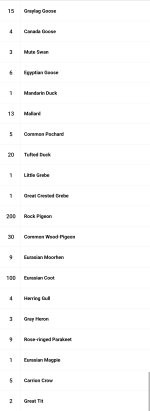Something Fishy
Well-known member

I spent a few hours in St. James Park today for the first time. I'm not at all familiar with the local birds and I can't figure out what is wild and "countable" and what isn't.
Some things are obvious - the black swan for example, and I believe the pelicans are captive as well. But what about the geese? The myriad of ducks? I'm guessing those marked as rare by ebird are captive...
See attached for an unsubmitted ebird checklist listing all the birds I saw. Any insight on what I should remove and what I should keep?
Some things are obvious - the black swan for example, and I believe the pelicans are captive as well. But what about the geese? The myriad of ducks? I'm guessing those marked as rare by ebird are captive...
See attached for an unsubmitted ebird checklist listing all the birds I saw. Any insight on what I should remove and what I should keep?








